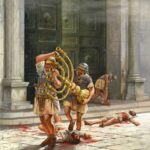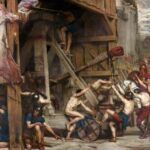Another discovery has been made at Masada, an ancient fortress built by king Herod the Great between 37 and 31 BCE. This discovery is the payslip of one of the Roman soldiers. This is a very important discovery due to the fact that it is only the third such document that has survived to our times.
The story begins with Herod the Great, who made Masada a royal stronghold. After his death, Masada was taken over by the Romans. The payslip is dated 72 CE. During this period, the Jewish uprising, also known as the Jewish-Roman War, was underway. At the end of this period, all resistance from Israel was suppressed. Masada was besieged by the Romans, so as to conquer it with the least effort and cost. Unfortunately, it was not known that there were not a large number of defenders in the fortress. There were probably fewer than 1,000 people there, including women, children, the elderly, and those unable to fight. During the final assault, it turned out that all people in the city committed suicide and there is no one to fight with.
The found payslip (stipendium) was found exactly where the Roman camp was located. From the papyrus, we can read that a certain Gaius Messius was paid. He received it after participating in the siege of the Jewish fortress and it amounted to 50 denarii. However, out of this amount he had to pay for barley fodder (16 denarii), food (20 denarii), shoes (5 denarii), leather belts (2 denarii) and a linen tunic (7 denarii). As it turns out, on the day of payment, the man received money, which he had to give back immediately in exchange for food and equipment.
Due to the fact that the document mentions animal feed, archaeologists believe that the man belonged to a Roman cavalry unit. From the papyrus, we can also read that the soldier came from the Fabia tribe from Beirut (present-day Lebanon).







